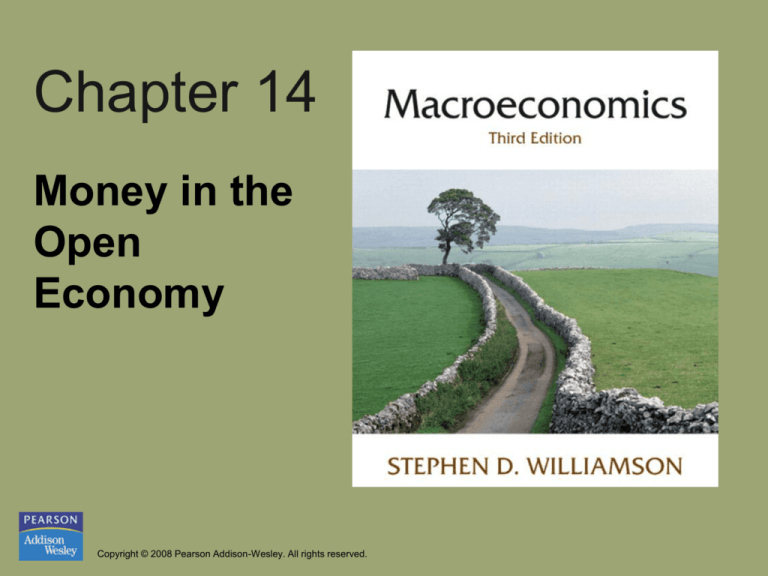
Chapter 14
Money in the
Open
Economy
Copyright © 2008 Pearson Addison-Wesley. All rights reserved.
Chapter 14 Topics
• Exchange rates and purchasing power parity.
• Flexible and fixed exchange rates.
• Monetary small open economy – fixed and
flexible exchange rates.
• Capital controls.
Copyright © 2008 Pearson Addison-Wesley. All rights reserved.
14-2
Equation 14.1
The purchasing power parity relationship – prices
are equalized across countries in terms of the
currency of one country.
Copyright © 2008 Pearson Addison-Wesley. All rights reserved.
14-3
Table 14.1 Purchasing Power
Parity and the Big Mac Index
Copyright © 2008 Pearson Addison-Wesley. All rights reserved.
14-4
Figure 14.1 The Real Exchange Rate
for Canada vs. the United States
Copyright © 2008 Pearson Addison-Wesley. All rights reserved.
14-5
A Monetary SOE – Flexible
Exchange Rate
• Model is identical to the small open economy
model with production and investment in
Chapter 13, with an added money market.
• The nominal exchange rate is essentially
determined by nominal money demand and
supply.
Copyright © 2008 Pearson Addison-Wesley. All rights reserved.
14-6
Figure 14.2 The Goods Market in the
Monetary Small Open-Economy Model
Copyright © 2008 Pearson Addison-Wesley. All rights reserved.
14-7
Equation 14.2
In the monetary SOE model, we assume that
purchasing power parity always holds.
Copyright © 2008 Pearson Addison-Wesley. All rights reserved.
14-8
Equation 14.3
Money demand depends on P, Y, and the world
real interest rate r*.
Copyright © 2008 Pearson Addison-Wesley. All rights reserved.
14-9
Equation 14.4
Substituting in the money demand equation using
the purchasing power parity relationship, and
equating money demand with money supply
gives:
Copyright © 2008 Pearson Addison-Wesley. All rights reserved.
14-10
Figure 14.3 The Money Market in the
Monetary Small Open-Economy Model
with a Flexible Exchange Rate
Copyright © 2008 Pearson Addison-Wesley. All rights reserved.
14-11
Figure 14.4 An Increase in the Money Supply in
the Monetary Small Open-Economy Model with
a Flexible Exchange Rate
Copyright © 2008 Pearson Addison-Wesley. All rights reserved.
14-12
Main Results with Flexible
Exchange Rate
• Money is neutral – the price level and nominal
exchange rate increase in proportion to the
money supply increase.
• A flexible exchange rate implies that the
domestic price level is insulated from
movements in the foreign price level.
• A change in the world real interest rate will
affect the domestic price level.
Copyright © 2008 Pearson Addison-Wesley. All rights reserved.
14-13
Figure 14.5 An Increase in the Foreign Price
Level in the Monetary Small Open-Economy
Model with a Flexible Exchange Rate
Copyright © 2008 Pearson Addison-Wesley. All rights reserved.
14-14
Figure 14.6 An Increase in the World
Real Interest Rate with a Flexible
Exchange Rate
Copyright © 2008 Pearson Addison-Wesley. All rights reserved.
14-15
Monetary SOE Model – Fixed
Exchange Rate
• In this version of the model, the domestic money
supply becomes endogenous rather than the
exchange rate.
• The money supply changes to equate money
supply and money demand at the fixed exchange
rate.
Copyright © 2008 Pearson Addison-Wesley. All rights reserved.
14-16
Figure 14.7 The Money Market in the
Monetary Small Open-Economy Model
with a Fixed Exchange Rate
Copyright © 2008 Pearson Addison-Wesley. All rights reserved.
14-17
Table 14.2 A Simplified
Government Balance Sheet
Copyright © 2008 Pearson Addison-Wesley. All rights reserved.
14-18
Main Results with a Fixed
Exchange Rate
• The SOE cannot have a monetary policy that is
independent of what happens in the rest of the
world.
• An increase in the foreign price level causes a
proportionate increase in the domestic price
level.
• A change in the world real interest rate has no
effect on the price level.
Copyright © 2008 Pearson Addison-Wesley. All rights reserved.
14-19
Figure 14.8 An Increase in the Foreign
Price Level in the Monetary Small OpenEconomy Model with a Fixed Exchange Rate
Copyright © 2008 Pearson Addison-Wesley. All rights reserved.
14-20
Figure 14.9 An Increase in the World
Real Interest Rate with a Fixed
Exchange Rate
Copyright © 2008 Pearson Addison-Wesley. All rights reserved.
14-21
Capital Controls
• Capital controls can dampen the effects of
macroeconomic shocks that come from abroad.
• However, capital controls cause inefficiencies in
world credit markets.
Copyright © 2008 Pearson Addison-Wesley. All rights reserved.
14-22
Figure 14.10 A Devaluation in
Response to a Temporary Total Factor
Productivity Shock
Copyright © 2008 Pearson Addison-Wesley. All rights reserved.
14-23
Figure 14.11 A Temporary Total Factor
Productivity Shock, With and Without
Capital Controls
Copyright © 2008 Pearson Addison-Wesley. All rights reserved.
14-24
Figure 14.12 A Total Factor Productivity
Shock Under a Fixed Exchange Rate,
With and Without Capital Controls
Copyright © 2008 Pearson Addison-Wesley. All rights reserved.
14-25






